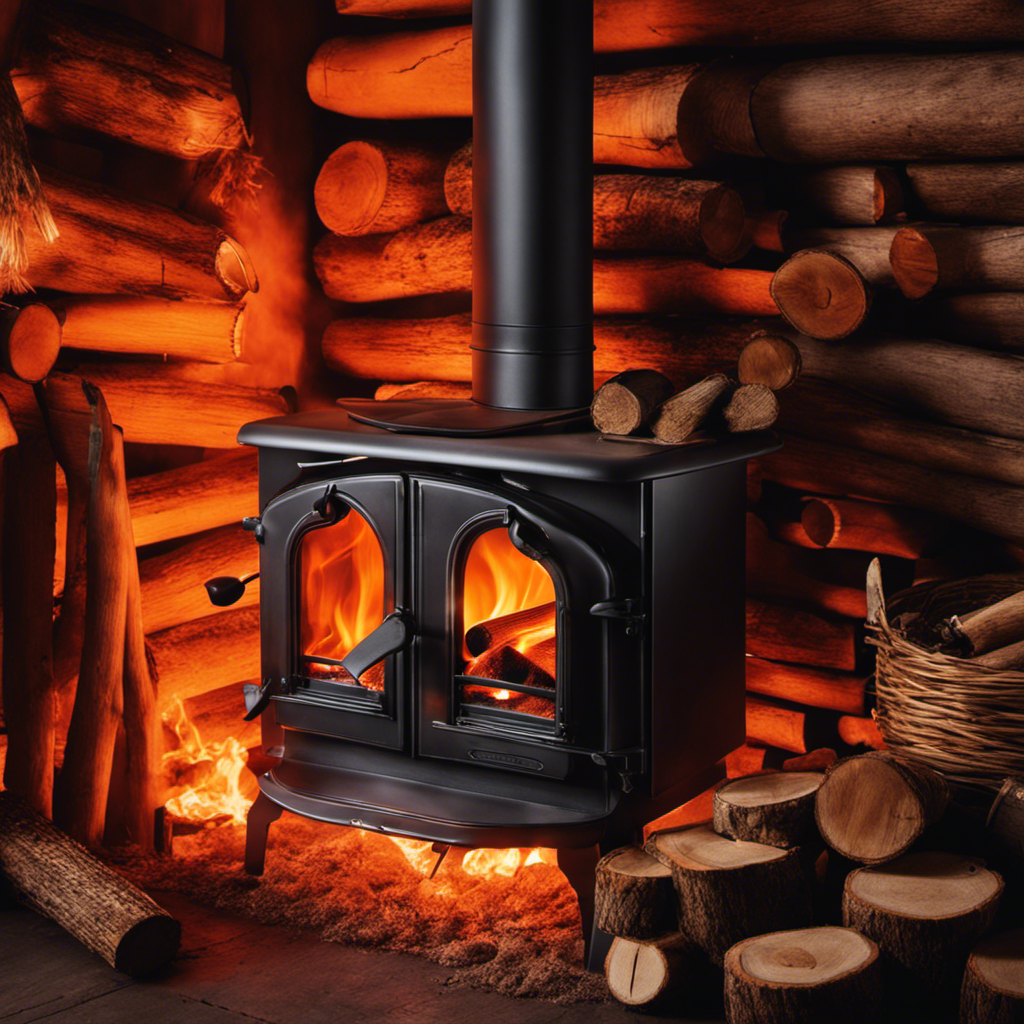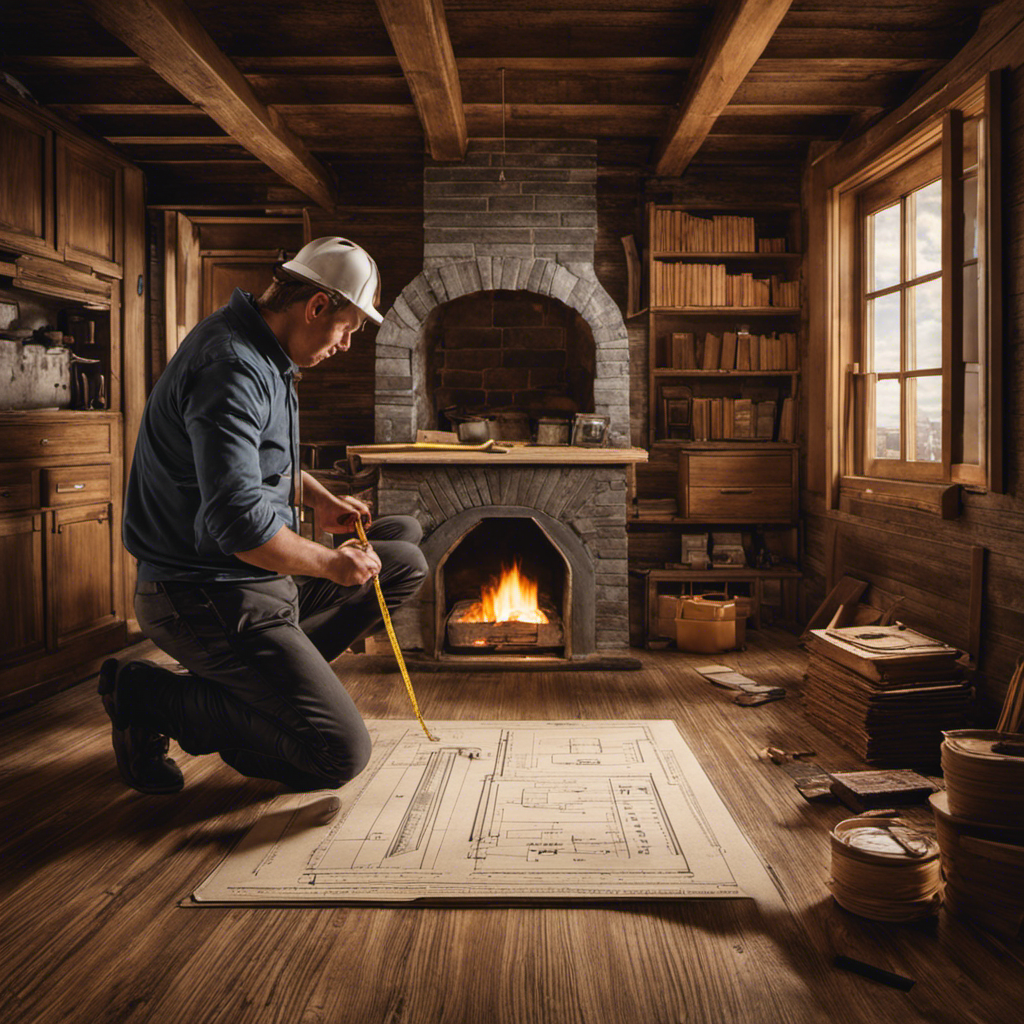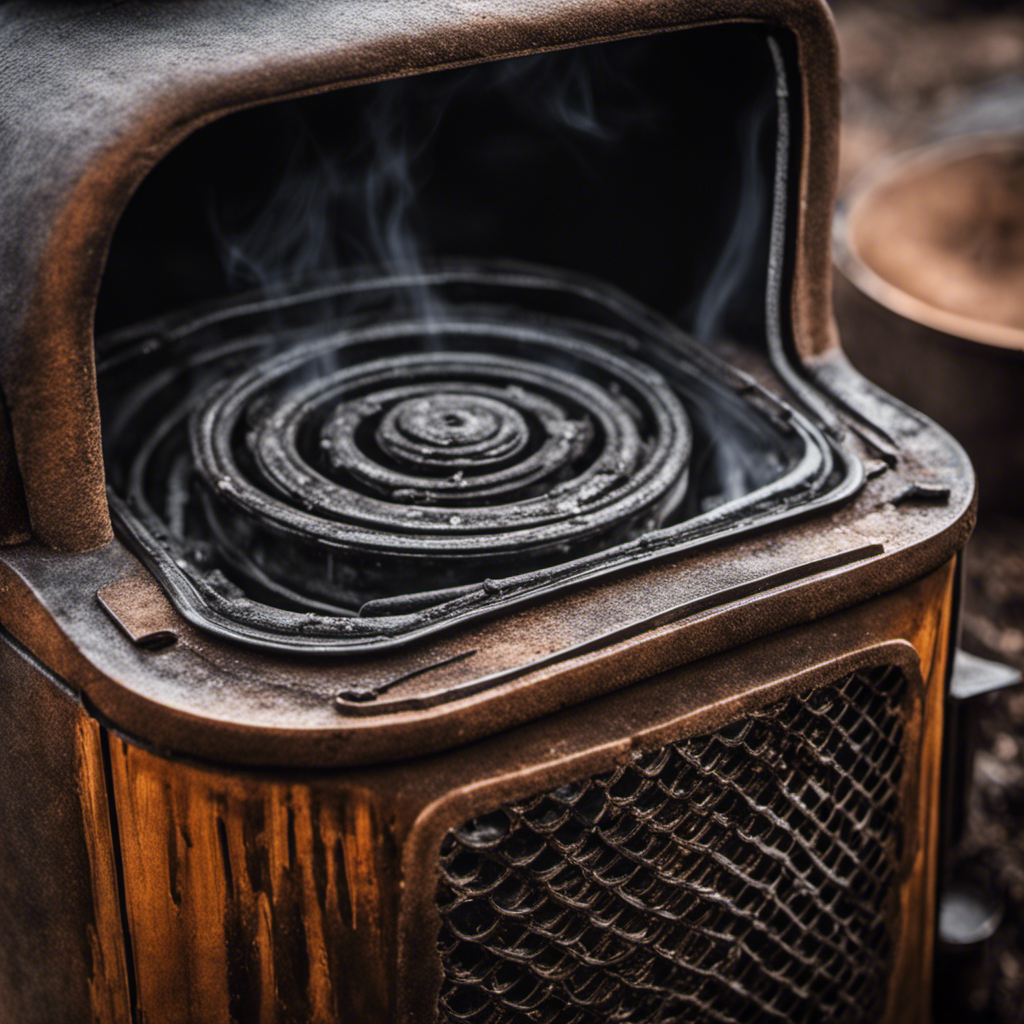As the saying goes, “Knowledge brings enlightenment, just as a wood stove brings warmth to the home.”
In this article, I’ll guide you through the ins and outs of working the heat of a wood stove. From understanding the basics of wood stove heat to controlling the heat output, I’ll provide you with the technical know-how to keep your home cozy and efficient.
So, let’s dive in and discover the secrets of mastering the art of wood stove heating.
Key Takeaways
- Regular maintenance and cleaning are crucial for maximum efficiency and preventing creosote buildup.
- Properly selecting seasoned firewood with low moisture content maximizes heat efficiency and reduces excessive smoke.
- Controlling heat output is possible by adjusting the air intake lever to regulate oxygen supply.
- Monitoring temperature and adjusting the air intake lever ensures optimal heat distribution and maintains a steady heat output.
Understanding the Basics of Wood Stove Heat
I love feeling the warmth of my wood stove’s heat on a chilly winter evening.
To ensure that my wood stove operates at maximum efficiency, regular maintenance is crucial.
The first step is to clean the stove regularly, removing any ash or debris that may accumulate. This not only improves the stove’s efficiency but also prevents the buildup of creosote, which can be a fire hazard.
Additionally, it’s essential to check the gaskets and seals regularly to ensure they’re intact and functioning correctly. These components help to maintain a proper seal, preventing heat from escaping.
Lastly, maximizing heat efficiency can be achieved by using properly seasoned firewood, as it burns more efficiently and produces more heat.
Preparing the Firebox for Efficient Heating
To ensure efficient heating, I regularly clean and inspect the firebox of my wood stove, as well as use properly seasoned firewood. When it comes to firewood selection, it’s essential to choose wood that has been dried for at least six months. This ensures that the wood has a moisture content of around 20% or less, allowing for a cleaner and more efficient burn.
Moisture-filled firewood not only produces less heat but also creates excessive smoke and creosote buildup in the firebox. Cleaning the firebox is crucial to maintain its efficiency. I make sure to remove any ashes and debris regularly, as they can obstruct the airflow and hinder the wood stove’s performance.
Additionally, inspecting the firebox for any cracks or damage is essential to prevent heat loss and potential safety hazards. By following these practices, I can enjoy a warm and efficient heat source during the colder months.
Controlling Heat Output With Air Intake
The air intake lever on my wood stove allows me to control the heat output by adjusting the amount of oxygen entering the firebox. Adjusting airflow for optimal heat distribution is crucial in maintaining a comfortable and efficient heating experience.
There are different methods of controlling heat output in wood stoves. One method is to partially close the air intake lever to reduce the oxygen supply, which slows down the combustion process and lowers the heat output. Conversely, fully opening the air intake lever allows for maximum oxygen intake, resulting in a higher heat output.
Maintaining Optimal Heat Levels Throughout the Day
Adjusting the air intake lever and regularly monitoring the temperature are essential for maintaining optimal heat levels throughout the day.
When it comes to maintaining consistent temperature in a wood stove, it’s important to understand how to maximize heat efficiency.
Firstly, adjusting the air intake lever allows you to control the amount of oxygen entering the stove, which directly affects the combustion process and heat output. By opening the lever slightly, you can increase the airflow and promote a hotter fire. However, it’s crucial to find the right balance, as too much oxygen can lead to excessive heat loss.
Secondly, regularly monitoring the temperature using a thermometer is necessary to ensure that the stove is operating within the desired range. This allows you to make necessary adjustments and maintain a steady heat output throughout the day.
Tips for Safe and Effective Wood Stove Operation
As an owner of a wood stove, I rely on proper maintenance and regular inspections to ensure safe and effective operation.
One important aspect of wood stove operation is firewood selection. It’s essential to choose well-seasoned firewood with low moisture content to prevent excessive smoke and creosote buildup. Hardwoods like oak and maple are ideal because they burn longer and produce more heat. Softwoods like pine should be avoided as they burn quickly and can contribute to chimney buildup.
Additionally, regular cleaning is crucial to maintain the efficiency of the wood stove. Cleaning involves removing ash and soot from the firebox, flue, and chimney. A professional chimney sweep should be hired annually to inspect and clean the chimney thoroughly.
Following these guidelines for firewood selection and cleaning and maintenance will ensure safe and effective operation of your wood stove.
Frequently Asked Questions
How Do I Clean the Exterior of My Wood Stove?
To clean the exterior of my wood stove, I use a damp cloth or sponge with a mild soap solution. Gently scrub the surface, making sure to remove any dirt or debris. Regular cleaning and maintenance will keep your stove looking great.
Can I Use Softwood in My Wood Stove?
Using softwood in a wood stove is possible, but hardwood is recommended for better heat output and longer burn times. Hardwood is denser, burns hotter, and produces less creosote buildup.
What Should I Do if There Is a Strong Smell of Smoke in My House When Using the Wood Stove?
If there’s a strong smell of smoke in my house while using the wood stove, I would troubleshoot by checking for any leaks or cracks and ensuring proper ventilation.
How Often Should I Have My Wood Stove Inspected or Serviced?
To ensure optimal functioning and safety, it is crucial to regularly inspect and service your wood stove. Neglecting wood stove maintenance can lead to potential issues and malfunctioning. Stay proactive and schedule routine check-ups.
Are There Any Specific Regulations or Permits Required for Installing a Wood Stove in My Home?
There are specific regulations and permits required for installing a wood stove in my home. It is important to comply with these rules to ensure safety and to meet the legal requirements of my area.
Conclusion
In conclusion, understanding the basics of wood stove heat is crucial for efficient and safe operation. By preparing the firebox properly, controlling the heat output with air intake, and maintaining optimal heat levels throughout the day, you can ensure effective heating in your home.
Did you know that wood stoves can reach temperatures of up to 1000 degrees Fahrenheit? This interesting statistic highlights the power and potential of wood stoves as a heating source.











